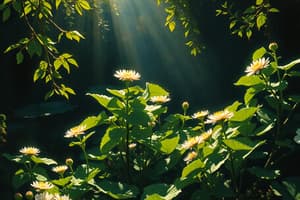Podcast
Questions and Answers
Which of the following statements best describes the role of autotrophs in an ecosystem?
Which of the following statements best describes the role of autotrophs in an ecosystem?
- They break down complex molecules into simpler ones.
- They consume other organisms to obtain energy.
- They convert light or chemical energy into food. (correct)
- They decompose dead organic material.
How do heterotrophs obtain energy for their life processes?
How do heterotrophs obtain energy for their life processes?
- By converting chemical compounds into glucose.
- By directly absorbing sunlight.
- By synthesizing organic molecules from inorganic substances.
- By consuming other organisms or organic matter. (correct)
In what way does the process of photosynthesis contribute to the energy needs of a cell?
In what way does the process of photosynthesis contribute to the energy needs of a cell?
- It directly produces ATP for immediate cellular energy.
- It breaks down glucose to release energy.
- It converts light energy into chemical energy stored in glucose. (correct)
- It synthesizes proteins needed for energy transport.
How do chemoautotrophs differ from photoautotrophs in the way they obtain energy?
How do chemoautotrophs differ from photoautotrophs in the way they obtain energy?
How do decomposers contribute to the bioenergetics of an ecosystem?
How do decomposers contribute to the bioenergetics of an ecosystem?
Which of the following is the primary function of ATP in cells?
Which of the following is the primary function of ATP in cells?
What is the role of chlorophyll in photosynthesis?
What is the role of chlorophyll in photosynthesis?
A caterpillar primarily consumes plant leaves. Which type of heterotroph is a caterpillar?
A caterpillar primarily consumes plant leaves. Which type of heterotroph is a caterpillar?
Which of the following best describes detritivores?
Which of the following best describes detritivores?
Which energy transformation is at the core of photosynthesis?
Which energy transformation is at the core of photosynthesis?
Flashcards
What is energy?
What is energy?
The ability to do work and is necessary for metabolism.
What are Autotrophs?
What are Autotrophs?
Organisms that can make their own food, also known as producers.
What are Photoautotrophs?
What are Photoautotrophs?
Autotrophs that use photosynthesis to convert light, water, and carbon dioxide into glucose.
What are Chemoautotrophs?
What are Chemoautotrophs?
Signup and view all the flashcards
What are Heterotrophs?
What are Heterotrophs?
Signup and view all the flashcards
What are Herbivores?
What are Herbivores?
Signup and view all the flashcards
What are Carnivores?
What are Carnivores?
Signup and view all the flashcards
What are Omnivores?
What are Omnivores?
Signup and view all the flashcards
What are Decomposers?
What are Decomposers?
Signup and view all the flashcards
What are Detritivores?
What are Detritivores?
Signup and view all the flashcards
Study Notes
- Bioenergetics is covered in Grade 11 Earth & Life Science
Learning Objectives
- Cells carry out functions essential for life
- Photosynthetic organisms utilize light energy to convert carbon dioxide and water into energy-rich compounds
- Organisms need energy to perform life functions
Energy
- Energy is the capacity to perform work
- It is crucial for metabolism
- The sun serves as primary energy source
How Organisms Obtain Energy
- Organisms usually obtain chemical energy from food
- Food comprises organic molecules storing energy in the form of chemical energy
Autotrophs
- Autotrophs produce their own food
- Producers create food for themselves and other organisms
Types of Autotrophs
- Photoautotrophs use photosynthesis
- Photosynthesis converts light, water, and carbon dioxide into glucose
- Photoautotrophs include plants and cyanobacteria
- Chemoautotrophs convert chemicals like sulfur, methane, and hydrogen sulfide into energy
- Chemoautotrophs include nitrogen-fixing and iron-oxidizing bacteria
Heterotrophs
- Heterotrophs cannot produce their own food and consume other organisms
- They can consume autotrophs, other heterotrophs, or both
- Heterotrophs are also known as Consumers
Types of Heterotrophs
- Herbivores mainly consume plants such as cows, horses, elephants, caterpillars, and giraffes
- Carnivores primarily consume meat/flesh of animals, and are also known as Predators
- Carnivores include bobcats, lions, foxes, eagles, tigers, and crocodiles
- Omnivores consume a variety of plants and meat/flesh of other animals
- Examples of omnivores are dogs, cats, pigs, chicken, gorillas, and rats
- Decomposers break down and secrete enzymes to digest remains of dead organisms such as fungi and bacteria
- Detritivores are animals that feed on dead organic material and plant detritus
- Detritivores include crabs, snails, earthworms, flies, and dung beetles
Energy-Giving Molecules
- Glucose is a sugar with molecular formula C6H12O6
- Adenosine Triphosphate (ATP) provides energy for use and storage at the cellular level
Photosynthesis Equation
- CO2 + H2O (+ Sun's energy and Chlorophyll) --> C6H12O6 + O2
Photosynthetic Organelles
- Chlorophylls are green pigments that absorb all wavelengths of light
- Carotenoids are yellow, orange and red pigments
- Phycobilins are pigments found in red algae that provide them with reddish color
Chloroplast
- Cholorplasts acts as a site of photosynthesis
Mitochondria
- Mitochondria is where ATP is synthesized
Studying That Suits You
Use AI to generate personalized quizzes and flashcards to suit your learning preferences.




